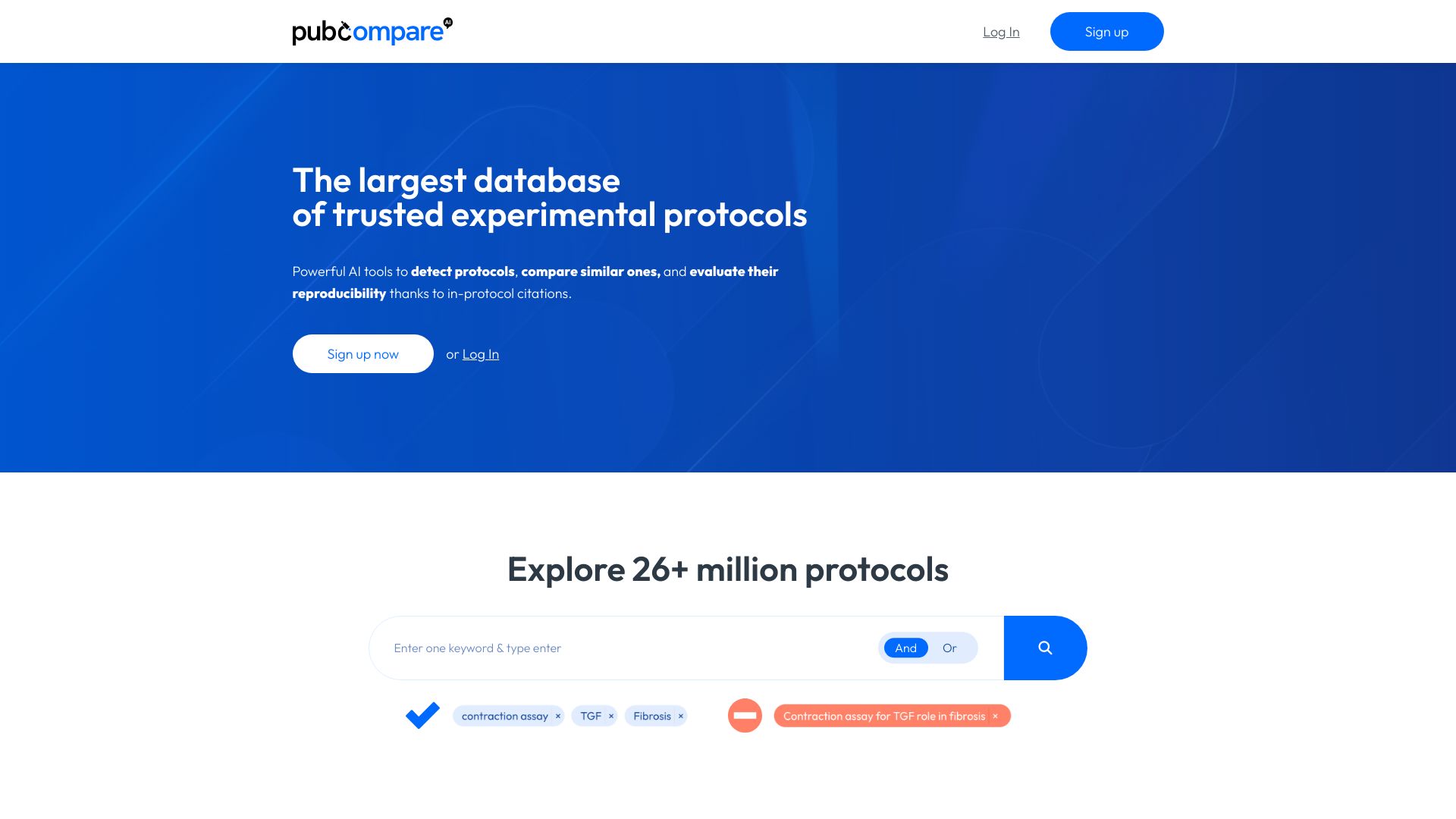
PubCompare
Open Website-
Tool Introduction:AI protocol search comparing methods across papers for reproducible research.
-
Inclusion Date:Oct 28, 2025
-
Social Media & Email:
Tool Information
What is PubCompare AI
PubCompare AI is an AI-powered search engine for experimental protocols. It enables scientists to search across publications, compare protocol sections side by side, and surface key methodological differences—such as reagents, timings, temperatures, and instruments—that influence outcomes. By highlighting reproducibility signals and contextualizing alternative steps, PubCompare AI helps minimize experimental failure, avoid duplicate research, and converge on best practices. It also supports collaboration by making evidence-based protocol decisions easier to share within teams.
PubCompare AI Main Features
- AI protocol search: Purpose-built search optimized for locating protocol sections in scientific literature.
- Side-by-side comparison: Align and compare protocol steps to reveal differences in materials, parameters, and workflows.
- Reproducibility insights: Tools to evaluate consistency across sources and assess methodological robustness.
- Difference highlighting: Identify impactful changes in concentrations, incubation times, temperatures, and equipment.
- De-duplication support: Detect overlapping methods to reduce redundant experiments and wasted resources.
- Collaboration-friendly: Facilitate shared review of protocol evidence to align teams on experimental design.
- Context filters: Narrow results by technique, domain, or other relevant protocol attributes.
PubCompare AI Ideal Users
PubCompare AI is suitable for bench scientists, principal investigators, method developers, and research students who rely on published methods. It also benefits biotech and pharma R&D teams, core facilities, and CROs that need to select, adapt, or standardize protocols with a focus on reproducibility and efficient knowledge transfer.
PubCompare AI How to Use
- Define your research question and the technique or assay you plan to run.
- Enter keywords describing target organisms, materials, instruments, or protocol steps.
- Browse protocol-focused results and open relevant publications.
- Add multiple sources to a comparison view to align sections step by step.
- Review highlighted methodological differences and note potential impact on outcomes.
- Use reproducibility cues to prioritize well-documented and consistent approaches.
- Record decisions and share selected comparisons with collaborators to finalize the protocol.
PubCompare AI Industry Use Cases
Academic labs can compare CRISPR editing protocols to optimize transfection conditions. Biotech teams can evaluate RNA-seq or ELISA preparation steps across papers to improve yield and signal-to-noise. Pharma researchers can contrast cell-based assay setups to standardize screening conditions. Core facilities and CROs can benchmark published protocols to create training materials and harmonized SOPs.
PubCompare AI Pros and Cons
Pros:
- Focused on experimental protocols rather than general literature.
- Side-by-side comparison exposes actionable methodological differences.
- Supports reproducibility by synthesizing evidence across sources.
- Helps reduce experimental failure and avoid redundant work.
- Facilitates collaboration and consensus on experimental design.
Cons:
- Usefulness depends on coverage and quality of indexed publications.
- Subtle context (e.g., lab-specific nuances) may be hard for AI to interpret perfectly.
- Not a substitute for domain expertise, pilot runs, or validation experiments.
- Access to some full texts may depend on publisher or institutional subscriptions.
PubCompare AI FAQs
-
How is PubCompare AI different from generic academic search?
It focuses on experimental protocols and provides side-by-side comparisons of method sections, helping you spot practical differences that affect reproducibility.
-
What methodological differences can it surface?
Differences in sample preparation steps, reagent types or concentrations, incubation times, temperatures, instruments, and quality control criteria.
-
How does it improve reproducibility?
By enabling comparisons across multiple publications, it reveals divergences and convergences in methods so teams can select better-documented, consistent approaches.
-
Who benefits most from PubCompare AI?
Bench scientists, PIs, method authors, R&D teams, core facilities, and students who need reliable, evidence-based protocol selection and optimization.
-
Is it useful beyond life sciences?
It is aimed at experimental disciplines where protocols are documented in publications; applicability may vary by field and available literature.
